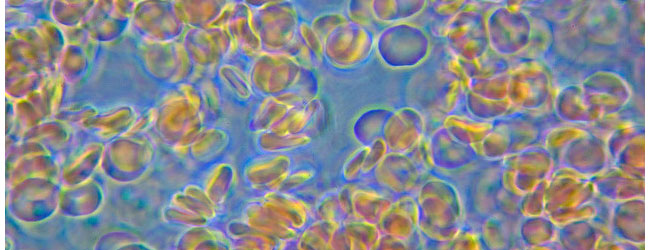What is Toluidine Blue?
Toluidine blue (TB) is a polychromatic dye that can absorb different colors depending on how it binds chemically with various tissue components.
It first emerged in 1856, courtesy of a British chemist called William Henry Perkin. Although he was working on the synthesis of quinine, Perkin instead produced a blue substance with good dyeing properties. Initially it became known as aniline purple or ‘Mauveine‘.
Being mostly used in the dye industry, this was the first synthetic organic chemical dye. Later it became known as TB, and began being used for medical purposes, in particular as a histological special stain to highlight certain components.
What Does it Stain?
This basic dye selectively stains acidic tissue components. It has a specific affinity for nucleic acids, and therefore binds to nuclear material of tissues with a high DNA and RNA content.
General Principles of the Stain
TB stains tissues via the phenomenon of ‘metachromasia’. Many dyes can show metachromasia, but the thiazine group dyes such as TB are especially good for this type of staining. This phenomenon refers to how a dye stains tissue components a different color from the dye solution and the rest of the tissue. In the case of TB, this strong, acidophilic, blue dye stains nuclei dark blue, but will stain mast cell granules and polysaccharides violet.
One advantage of using TB is that it is a relatively simple stain to perform, and the staining process is much quicker than that of routine haematoxylin and eosin staining.
Who Uses Toluidine Blue Stain?
This stain is used widely for both diagnostic and research purposes.
In diagnostic labs, TB is widely used by pathologists to highlight mast cell granules. This stain is particularly helpful when they need to evaluate patients with pathological conditions that involve mast cells, including cancers, allergic inflammatory diseases, and gastrointestinal diseases such as irritable bowel syndrome. It is also used to highlight tissue components such as cartilage or certain types of mucin.
Additionally, it can be used as part of the screening process for certain cancers, such as oral cancer- since it binds the DNA of dividing cells, precancerous and cancerous cells take up more of the dye than normal cells.
From Research Labs to Forensics
Similarly, researchers investigating any of these diseases or tissue components may also routinely examine TB-stained tissue sections. Other researchers may also use the stain simply because they come across something in tissue sections that needs to be identified. It may also be useful in electron microscopy for staining thin sections of resin-embedded tissues, in order to help with the orientation and visualization of samples. Although TB stains everything in the sample, structural details are especially prominent because the sections are so thin.
TB is also used in sexual assault forensic medical examinations. Because the dye is preferentially taken-up by injured cells, it can be used to identify damaged tissue in the genital tract, for instance.
How do you use toluidine blue in your lab?
Want to know more about histology? Visit the Bitesize Bio Histology Hub for tips and trick for all your histology experiments.






